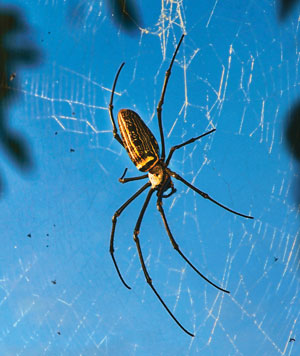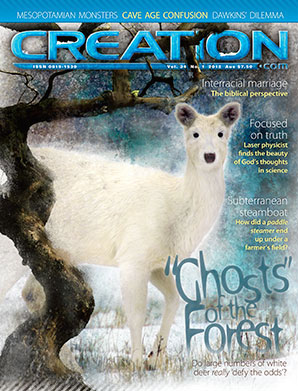Another web of evolutionary deceit
 ©iStockPhoto.com/joste_dj
©iStockPhoto.com/joste_djFossils are just one of many different pieces of evidence used to cause confusion between evolutionary theory and biblical history. Many of the fossil finds reported by the mainstream media are touted to be millions of years old but with no explanation of how the scientists reached that conclusion. The following fossil find is no exception.
LiveScience reports that scientists in Inner Mongolia, China, discovered an amazingly well-preserved fossil female golden orb-weaver spider, named Nephila jurassica, which is supposedly 165 million years old. Golden orb-weaver spiders are big enough to catch birds and bats in their web. The silk1 they use in their web shines like gold when sunlight catches it. This particular fossil was buried in volcanic ash and much to the scientists surprise, looks “about as large as its modern relatives, with a body one inch (2.5 centimeters) wide and legs that reach up to 2.5 inches (6.3 cm) long.”2
So, is this another example of a creature that lived ‘millions’ of years ago and yet is surprisingly similar to its modern counterpart? Absolutely. A similar example was reported in early 2010 by Wired Science.3 This particular fossil specimen, known as Eoplectreurys gertschi, was given the same age as Nephila jurassica. However, the Eoplectreurys specimen looks exactly like its living counterparts today. Paleontologist and lead author Paul Selden said to Wired Science, “The scimitar-shaped structure you notice out of the male is so distinctive. Looking at modern ones, you think, well, it’s just a dead ringer.”2
Selden, director of the Paleontological Institute at the University of Kansas, said in the LiveScience article, “It would have lived, like today’s Nephila, in its orb web of golden silk in a clearing in a forest, or more likely at the edge of a forest close to the lake. There would have been volcanoes nearby producing the ash that forms the lake sediment it is entombed within.” So, apparently it not only looks like today’s golden orb-weaving spiders, but it also would have lived like them as well. This comes as a surprise to those who believe in the evolutionary framework of history; but not to those who believe in the biblical timescale.
The typical evolutionary long-ages description of how creatures become fossilized involves a very slow and gradual process of sedimentary layers of rock and/or ash being laid down over vast eons of time. However, any operational science experiment will show that a dead creature will not last long exposed to the elements. Things left out in the open succumb to the decay process and will likely be completely gone within a year. In order to fossilize something in sedimentary layers of rock or ash, it must be buried quickly. This is especially true of fairly soft-bodied boneless creatures like spiders. They cannot be exposed to the elements for very long before their bodies completely disintegrate. This destruction can come about in several different ways: microbial decay, scavengers and precipitation, to name just a few.
How do evolutionists handle this? They add yet another fossil find to the ever-expanding category of creatures that don’t fit evolution’s storyline of change over time. However, it fits much better with a recent creation of spiders made to reproduce ‘after their kind’ and being buried during the global Flood as recorded in Genesis. It’s very likely that this spider was entombed in ash from a volcanic eruption when the fountains of the great deep burst open and the floodgates of the sky were let loose. The ash then turned to stone, forever preserving this particular spider.
References
- God’s webspinners give chemists free lessons, Creation 23(2):20–21, 2001; creation.com/spidersilk Return to text.
- Choi, C.Q., Largest Fossil Spider Found in Volcanic Ash, LiveScience, www.livescience.com, 19 April 2010.. Return to text.
- Ghose, T., Stunningly Preserved 165-Million-Year-Old Spider Fossil Found, Wired Science, www.wired.com, 9 February 2010. Return to text.





Readers’ comments
Comments are automatically closed 14 days after publication.